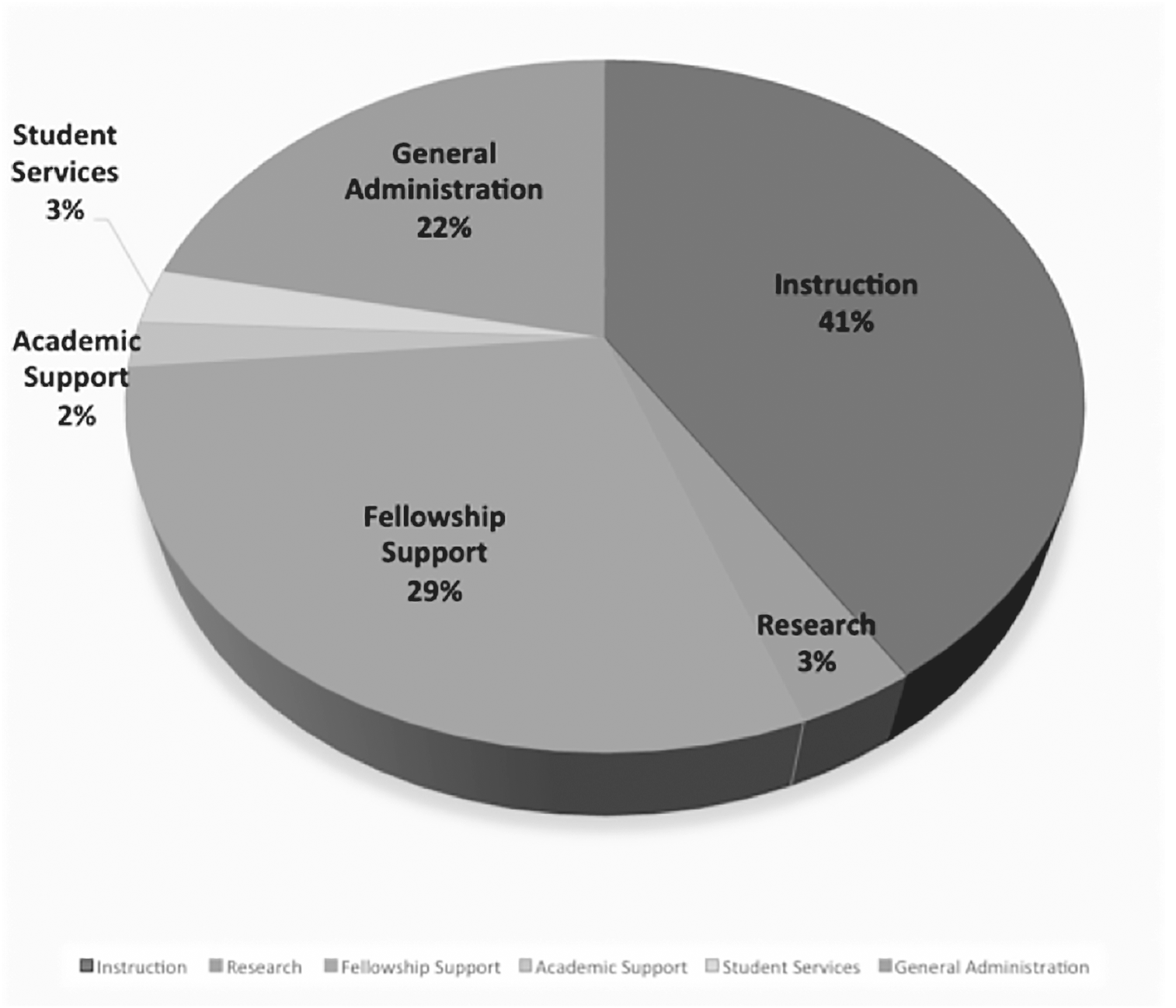Angela Dunne and Conor Tomás Reed
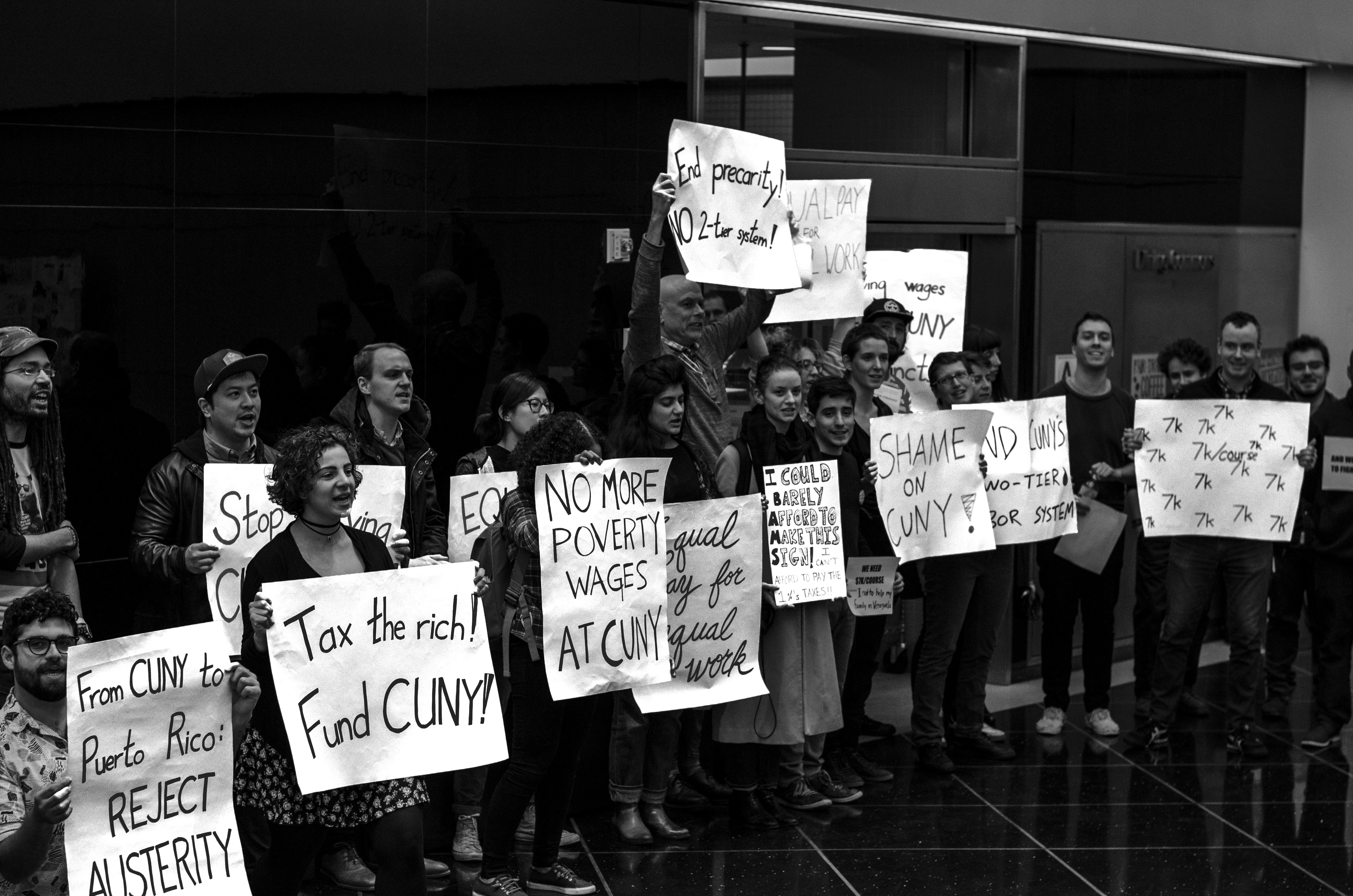 There’s an old joke that radicals have predicted fifty of the last five uprisings. In the tunnel vision of organizing—campaigns, petitions, protests, conference calls, meetings, late-night plots—a spark can be perceived as The One that will start a wildfire. An isolated grievance can be anticipated as the prism to refract broader injustices. The triumphant sounds of History may actually be the grinding gears of movement work slowly inching forward, backwards, forwards. But sometimes, in a rare confluence moment, what we do to radically improve our well-being can invoke tremendous impacts in the spaces where we live, study, and work.
There’s an old joke that radicals have predicted fifty of the last five uprisings. In the tunnel vision of organizing—campaigns, petitions, protests, conference calls, meetings, late-night plots—a spark can be perceived as The One that will start a wildfire. An isolated grievance can be anticipated as the prism to refract broader injustices. The triumphant sounds of History may actually be the grinding gears of movement work slowly inching forward, backwards, forwards. But sometimes, in a rare confluence moment, what we do to radically improve our well-being can invoke tremendous impacts in the spaces where we live, study, and work.
Nationwide, as the Janus v. AFSCME Supreme Court ruling looms over public unions’ futures until its likely passage in June 2018, graduate students are calling for walkouts on 29 November against a federal tax revision that could eviscerate our funding packages. At the City University of New York, CUNY Chancellor Milliken has announced his resignation from a four-year tenure for the end of Spring 2018. The job contract between the Professional Staff Congress (PSC) and CUNY management expires this 30 November, a date that will mark grassroots PSC actions across the university to center adjuncts professors’ demands for $7k/class and job security. The Campaign to Make CUNY Free Again (Free CUNY) is pressuring the City Council, Mayor de Blasio, and Governor Cuomo to fully fund tuition with taxes on New York’s ultra-wealthy. Meanwhile at the Graduate Center, a new Budget Transparency and Democratization (BT&D) and labor rights campaign has besieged the Graduate Center’s administration, especially as GC President Chase Robinson has proposed an “Academic Excellency Fee” increase of up to $1,200/semester for Master’s students.
Neil Smith, the late Marxist geographer who taught for over a dozen years at our school before his early death, once spoke of “scales” that enact “spatialized politics.” For Smith, the body, home, community, urban city, region, nation, and globe were key co-constitutive sites of transformative change. In pivotal moments, people can “jump scales” so that the interplay between ourselves and each other, our living conditions at home and our neighborhoods, and political shake-ups across our city, can reconfigure the country and world (and vice versa, back and forth). To jump scales at CUNY, then, suggests that between our individual livelihoods, campus struggles over the PSC contract and tuition, the GC and CUNY administration’s worsening legitimacy, de Blasio and the city, Cuomo and the state, and tax attacks and the Janus ruling on a national level roiling with public outrage, a multitude of sparks can spread widely.
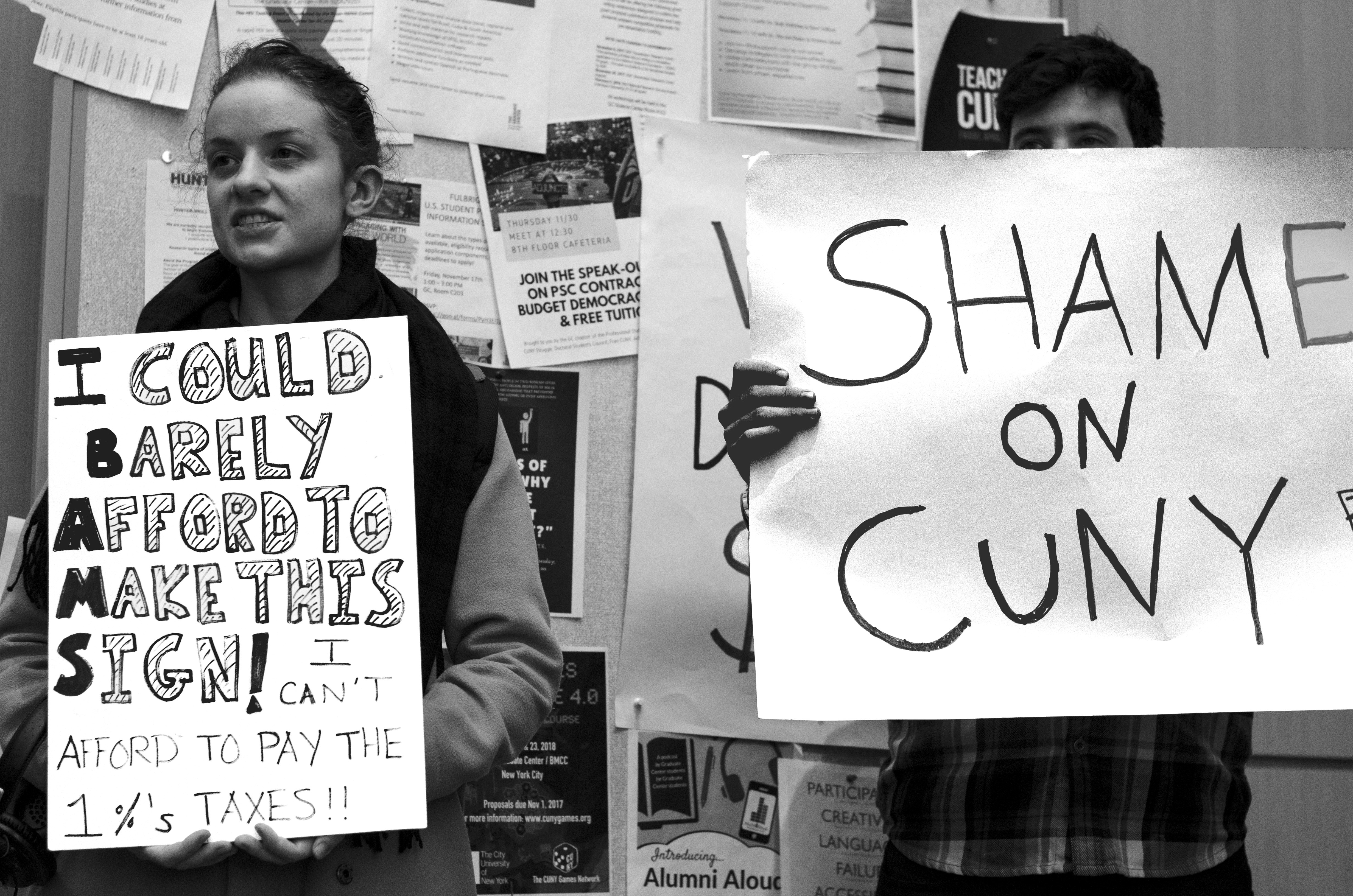 We CUNY students, faculty, and staff can powerfully co-conspire in this moment. Key to jumping scales is circulating our first-person testimonies towards group base-building, and creating relevant direct actions that can be remixed in different arenas by wider groups of people. The Graduate Center and the PSC have crucial roles to play. GC campaigns for $7k/class, job security, and free tuition can outwardly spread at the campuses where we fan out to work, as BT&D’s demands to intervene in GC budgeting can scale upwards to address rampant CUNY fiscal mismanagement. The GC’s politically activated and increasingly precarious graduate student body mirrors the national scene of graduate students/adjuncts that demand sweeping changes in universities and the government. Moreover, the PSC’s position as a public sector union advocating salary redistribution for adjuncts can redefine the momentum for adjunct struggles nationwide.
We CUNY students, faculty, and staff can powerfully co-conspire in this moment. Key to jumping scales is circulating our first-person testimonies towards group base-building, and creating relevant direct actions that can be remixed in different arenas by wider groups of people. The Graduate Center and the PSC have crucial roles to play. GC campaigns for $7k/class, job security, and free tuition can outwardly spread at the campuses where we fan out to work, as BT&D’s demands to intervene in GC budgeting can scale upwards to address rampant CUNY fiscal mismanagement. The GC’s politically activated and increasingly precarious graduate student body mirrors the national scene of graduate students/adjuncts that demand sweeping changes in universities and the government. Moreover, the PSC’s position as a public sector union advocating salary redistribution for adjuncts can redefine the momentum for adjunct struggles nationwide.
From our Graduate Center grounds, how can we measure the stakes of this conjuncture, and how can we work together to shape it? The Fall 2017 semester’s escalation campaign has been formed by an emerging ad-hoc coalition that includes the CUNY Adjunct Project, CUNY Struggle, Doctoral Students Council (DSC), Free CUNY, the Graduate Center PSC chapter, and concerned GC students — a cross-organizational collaboration of students, faculty, and staff not seen at this university for several years. In truth, these groups are but a fraction of our GC and CUNY communities. As a way to welcome many new and seasoned participants into this process, we offer a semester chronology of how we got here:
The Fall 2017 semester began with a new elected leadership of our GC PSC chapter, the New Caucus and Fusion Independents (NCFI), who had won two-thirds of the vote to CUNY Struggle’s third in May. Despite a combative Spring election campaign season, both slates agreed to continue working together at the Graduate Center. Indeed, because of Spring debates that compelled people on both slates to clarify their positions on union democracy, adjunct demands, and protest strategies, a reciprocal engagement between radicals of various stripes has improved the cohesion of campus organizing. A CUNY Struggle-initiated 26 September picket line outside the offices of Cuomo and CUNY Central, amassed 100 people from around CUNY and NYC. The PSC central leadership refused to mobilize members for the rally, which placed it in the embarrassing position of being outflanked on the new contract campaign by its own grassroots rank-and-file dissenters.
A 10 October City Hall Press Conference announced that Free CUNY had accrued over 4,000 petition signatures towards a public referendum to eliminate tuition, which they urged the City Council Task Force on CUNY Tuition to adopt as part of its December report to the Mayor. At the event, dozens of people from around the university linked free tuition to the future of ethnic studies, immigration reform, admissions requirements, and teaching conditions. A 12 October event by CUNY Struggle, “Get the Contract You Deserve!: $7k and Job Security for Adjuncts,” laid out a strategy for the new contract campaign that could more “horizontally” connect adjuncts across campuses, instead of only taking top-down perspectives and orders from PSC central communications and mobilization calls.
At the 16 October CUNY Board of Trustees Public Hearing, members of Free CUNY and the CUNY Rising Alliance demanded that the Board not raise tuition by $800 over four years, stop paying poverty wages to adjuncts, and do everything in its power to urge Cuomo to sign the Maintenance of Effort (MOE) Bill to secure basic operational CUNY funding. The Chancellor disappeared halfway through the testimonies, in violation of the public hearing’s regulations. A week later, the Board kicked out concerned students, CUNY workers, and community members, and raised the tuition anyway.
The 19 October PSC Delegate Assembly was a differently disorienting affair, in which the central leadership proclaimed $7k/class for adjuncts as their top priority (without mentioning the above events that rank-and-file adjuncts had organized), but then urged the delegates to vote down every single other adjunct and graduate teaching fellow (GTF) amendment to the contract demands regarding pay parity, seniority, etc. One long-time professor even made an important point that the contract demand for a 5% pay increase across the board would maintain pay inequities between adjuncts and non-disposable faculty, instead of redistribute salaries more equitably, but they were then accused of embracing the “austerity logic” of the CUNY administration. With great familiarity with Robert’s Rules of Order, the central leadership interjected multiple times, as a line of a dozen mostly adjuncts and graduate students waited to speak once. At the 9pm discussion cut-off time, tenured/tenureable faculty proposed for the stack list to be cut, thus silencing their fellow contingent union members, at which point a majority vote was taken to accept the contract demands.
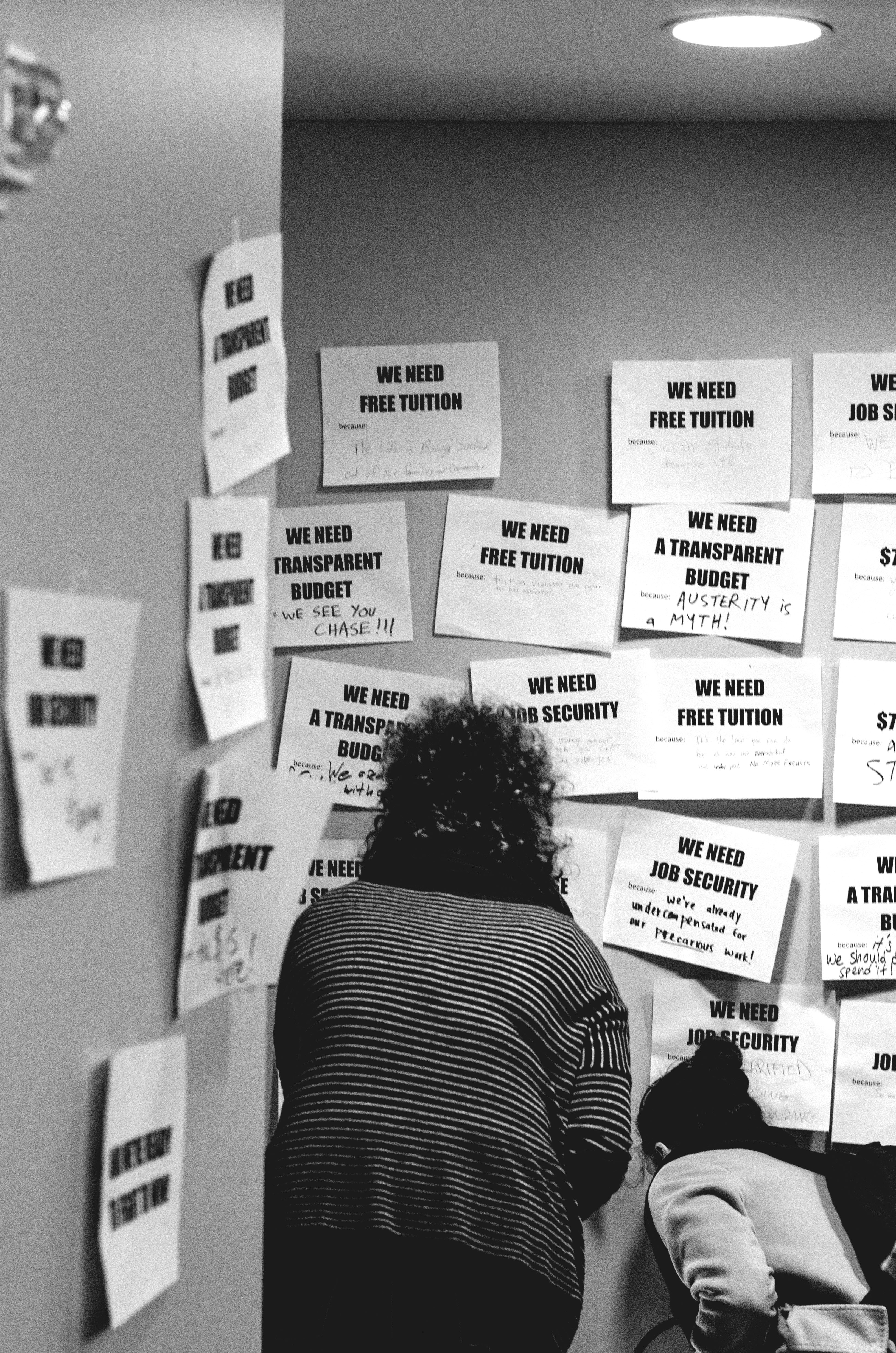 Even with this disheartening experience, it was good to see a few dozen of the attending delegates who have been immersed in CUNY and NYC movement work over the last several years around tuition hikes, budget cuts, free speech rights, anti-ROTC and campus militarization, the last contract’s strike authorization, and various citywide campaigns. GC organizers noted that if we systematically develop a list of these delegates, and consistently reach out to them with our events and perspectives for the new contract, we could bypass the Delegate Assembly and begin to cohere a more direct democratic orientation to membership collaboration and communication. A sizeable number of these sympathetic delegates could pass along our efforts to their chapters (and vice versa, back and forth), as we map out which chapters might “turn” towards rank-and-file militancy.
Even with this disheartening experience, it was good to see a few dozen of the attending delegates who have been immersed in CUNY and NYC movement work over the last several years around tuition hikes, budget cuts, free speech rights, anti-ROTC and campus militarization, the last contract’s strike authorization, and various citywide campaigns. GC organizers noted that if we systematically develop a list of these delegates, and consistently reach out to them with our events and perspectives for the new contract, we could bypass the Delegate Assembly and begin to cohere a more direct democratic orientation to membership collaboration and communication. A sizeable number of these sympathetic delegates could pass along our efforts to their chapters (and vice versa, back and forth), as we map out which chapters might “turn” towards rank-and-file militancy.
Back at the Graduate Center, a 27 October DSC Town Hall, hosted by the Student Life and Services Committee, collated concerns by Master’s and Ph.D. students to bring to the administration. Then, a 31 October Adjunct Project “Haunting” went trick-or-treating for $7k/class, universal grad fellowships, health insurance, and tuition remission in the GC lobby and then right to Chase Robinson’s office door. Although he was is the office, he did not make himself available, so they informed the GC’s Public Safety Director about their trick-or-treat demands. He wrote them down and said he would pass them on to the President.
At a 2 November Community Meeting, Chase Robinson and Provost Joy Connolly discussed budgetary matters, the proposed “Excellency Fee” tuition increase of up to $1,200/semester for Master’s students, new faculty hires, and departmental diversity. Below we outline this meeting’s contents in-depth to present the GC administration’s purported commitment to community, in contrast to the grassroots initiatives otherwise laid out in this chronology. While the Graduate Center has 3723 students (3200 PhD and 500 Master’s), 140 central faculty, and hundreds of staff members in several unions, the meeting of three dozen people was mostly populated by the administration and their upper-level staff. Even though it was framed as a place to talk “among colleagues” in which Robinson and Connolly were open to hearing community concerns, it proved to be a rigidly designated hour to address the GC administration and each other to perform the bare minimum of creating community. The limited amount of critical information came as a result of persistent questioning from several concerned students in the audience, including members of the DSC and the GC PSC chapter:
- Will you release itemized budgets for the last 3-5 years?
- More details on budget transparency: Who sits on the budget committee and how is it formed?
- How can we democratize budget decisions/design/implementation?
- How do we know the money from the proposed “Academic Excellency Fee” — will go to services for Master’s students?
- To Robinson: you are the one of the top five highest paid CUNY administrators, will you commit part of your salary for the excellency fee?
- To Connolly: Your office’s data on diversity is missing class information. GC is at risk of becoming a gentrifying force in CUNY, what about data on students who come here from the senior colleges?
- Budget Itemization:
One Biology PhD student asked: Is it possible to have access to itemized budgets from the past five years? Chase Robinson answered that the budget at the Graduate Center is extremely dynamic and 79% goes to academic affairs. He also stated that there is a breakdown of major budget categories available online.
He was referring to this graph:
The student responded that asking for the historical data from the past five years will not change and thus would not be dynamic, and also, that the bulk calculations online do not provide much transparency about how the funds are actually being used. Robinson then deferred the question to Sebastian Persico, the Senior Vice President for Finance and Administration, who, along with President Chase Robinson, are two of the five highest paid administrators at the Graduate Center. Persico replied, “I’m not sure what itemized means” and subsequently added that the organization on a massive 125 million dollar budget could be overwhelming. He suggested that the student “have a better idea of what itemized means.” Robinson offered that he was happy to make the major categories available, as is the practice, but has seen no benefit in detailing the budget, implying that this leads to questions about decisions on discretionary funds. The student stated that they would follow up on an itemization request to the Finance and Administration office.
- Budget Committee. Who makes the decisions?
The next question also pushed on budget transparency and specifically asked about the individuals that sit on the Budget Committee that Robinson mentioned throughout the meeting, as well as how that committee is formed. The student asked about ways that students at the Graduate Center can get onto the committees. Robinson responded that the members are drawn from both the Faculty Steering Committee and the Council of Executive Officers. He also admitted that in these 3-4 years of budget cuts, there has been virtually no discretionary spending, and that budget decisions have been left up to the VP offices, and especially the Office of the Provost. The mechanisms that he offered for more student input were simply to present requests at a meeting with the Provost or himself. The Provost also provided information about how her office requires more transparency from departments in requiring them to record their requests for hires, units, and fellowship lines in a written document. However, neither of these answers addressed the question of student involvement in budgetary decisions. Making verbal requests at meetings with an undemocratically appointed President and Provost, with no voting or consensus procedure, is hardly as democratic a process as Chase Robinson claims.
- What about Participatory Budgeting?
One student wanted to push further on this question of democracy, stating that everything he heard in the meeting suggested that the governing processes at the Graduate Center were undemocratic. He proposed the implementation of Participatory Budgeting (PB): a process where community members decide how to spend part of a public or institutional budget. PB has been implemented at other CUNY campuses, like Queens and Brooklyn College, as well as within local New York City government. The Doctoral Student Council (DSC) has already begun a PB initiative that opens up the Student Activity Fee for the development of student-led projects. The further expansion of Participatory Budgeting at the GC would provide a more equitable and democratic process to develop budget resolutions, rather than leaving decisions about student needs up to the mercy of those at the top.
- What’s so “excellent” about a tuition increase for Master’s students?
In his initial address, Chase Robinson mentioned that the GC has filed a request to CUNY Central Offices for a tuition increase for its 500 Master’s students of 100 dollars more per credit. They are calling it the “Academic Excellency Fee” and claim that the money will go toward more resources for those students, namely, advisement, career training, internships, and scholarships. A Master’s student and member of the DSC asked: How can we be sure where the money from this tuition increase will go if the budget is not transparent? He asked if Robinson would commit to making decisions around this fee transparent with an itemized report. The student also addressed the fact that the DSC has a clear and itemized budget available for each spending year and there is no reason that the administration cannot do the same. Robinson responded that the proof of allocation will be in the infrastructure that is built for Master’s students. The Provost responded that the money will be used for resources that Master’s students themselves have said that they want. This brings back the question of the claim that the request-making procedures at the Graduate Center are democratic. Does it make sense to charge more tuition for the students at the Graduate Center that receive no fellowships and are starved for resources? The Provost and President claimed that they have been thinking on this issue for three years and this is the decision that they came to reluctantly. However, a more democratic budgetary decision process could have developed more egalitarian solutions that don’t sidestep the rights of Master’s students.
- How do you fix a deficit? Chop from the top.
One English PhD student noted that, according to June 2016 figures, Chase Robinson was among the top five highest paid administrators in CUNY with an annual salary of $350,000. The student proposed, if Robinson wished to demonstrate his support for the excellence of Master’s students in the Graduate Center, would he then consider paying the tuition increase himself? Robinson was furious to hear this suggestion, which he quickly refused.
- Diversity, Class, and Gentrification at CUNY
In response to Joy Connolly distributing to the room a series of colorful graph print-outs about improved ethnic and gender student diversity at the Graduate Center, the same English student noted that these changes had occurred as a result of student, faculty, and staff pressure upon the administration and their departments across the last several years. However, the student added, Connolly’s graphs didn’t include information on class diversity or stratification, and in particular, statistics on how many CUNY students were being admitted into the Graduate Center. The student offered that if the Provost’s Office was concerned with diversifying the student body, then they could focus more on orienting admissions to the existing CUNY student population. Otherwise, the Graduate Center runs the risk of gentrifying its graduate student body with wealthier students (even within broader ethnic and gender spectrums) who may pursue certain upper-class-oriented studies and teach diverse working-class CUNY undergraduates from elite outsider positions. Connolly agreed that the information for economic class is important but that she imagined it would be difficult to get. The student responded that data about those admitted from CUNY undergraduate colleges would suffice. Connolly then evaded the previous question addressed to Chase Robinson, by reiterating how important Master’s students were to the Graduate Center community, which unintentionally made Robinson glare again.
At the 13 November GC PSC Chapter meeting, a resolution against the master’s students tuition hike was unanimously passed, and members were urged to practice cross-title solidarity, with the demand for $7k/class minimum to be fought by adjuncts alongside everyone else. Then on 15 November, twelve master’s and doctoral students held a collective meeting with Chase Robinson and Matthew Schoengood that lasted almost an hour. Under the umbrella demand of Budget Transparency and Democratization (BT&D), students opposed the “Excellency Fee” tuition hike, uneven funding and limited tuition remission, and their general hardship. Students also identified the president’s overall failure to be available, accountable, and effectively raise money for the college. While Robinson vaguely offered to include students in the budgetary process and reach out to alumni for fundraising, he refused to rescind the tuition increase or address uneven funding packages. In contrast, at the 17 November DSC Plenary, representatives unanimously passed resolutions on three issues: 1) Endorsing a Tuition Freeze for Academic Year 2018-19, 2) Supporting the Adoption of the MOE Bill, and 3) Opposing the Plan to Implement an ‘Excellency Fee’ for Masters’ Students.
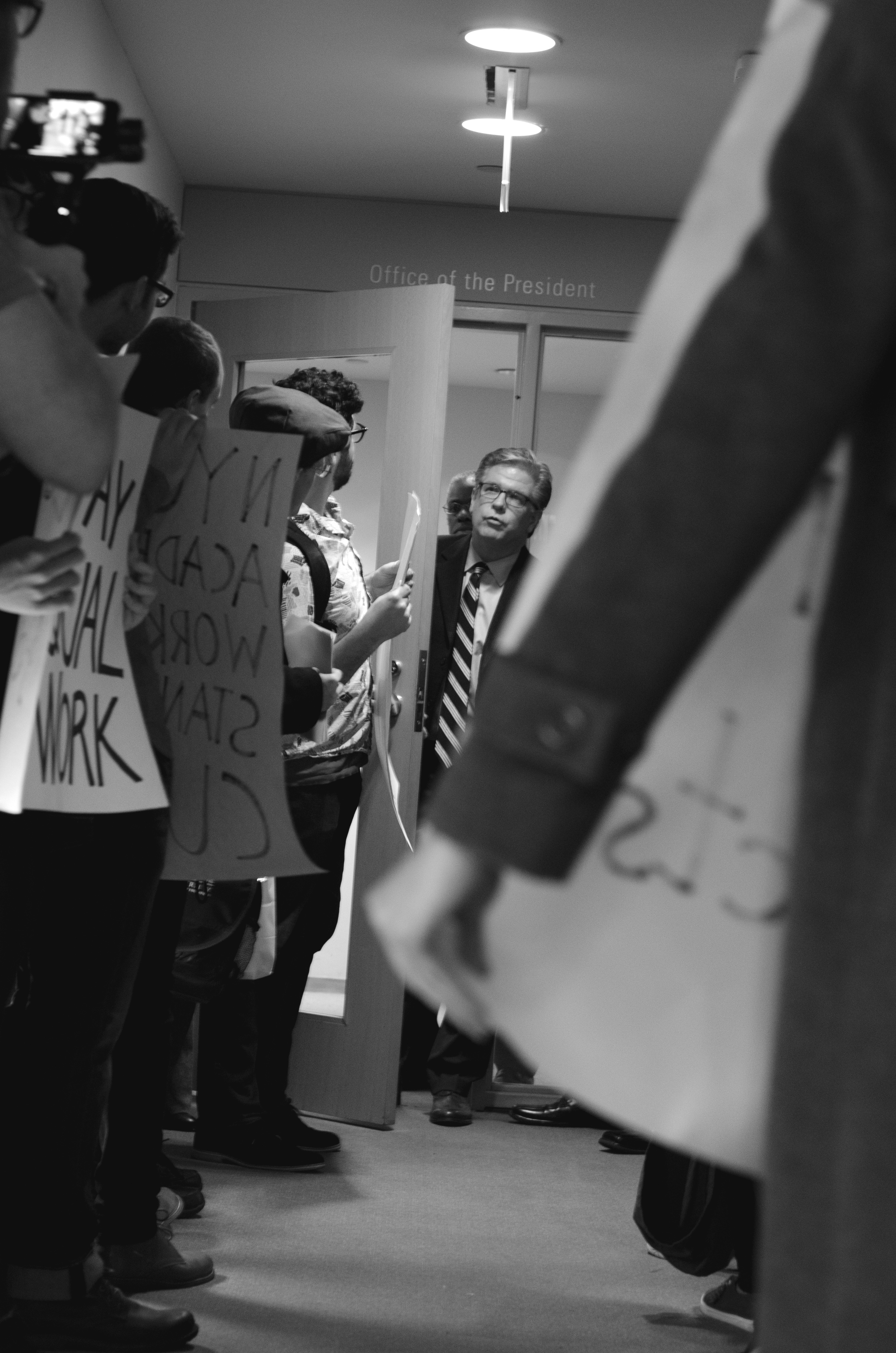 Also on 17 November 17, the Murphy Institute (CUNY) and the Worker’s Institute (Cornell) put on a joint conference, Janus and Beyond: The Future of Public Sector Unions. It featured talks and workshops that asked participants to re-imagine and explore strategic options toward a new labor movement in response to the threat of Janus vs. AFSCME. There was a strong current that spoke about Janus as an opportunity to restructure the top-down mechanisms in our unions, a sentiment that echoes many of the democratization and adjunct struggles at CUNY. City Council Member, I. Daneek Miller, spoke about how unions need to adopt the philosophy of starting from the shop floor. He also mentioned the dire situation of Local 3 and their now eight month strike against Spectrum Cable with many workers running out of their unemployment and Spectrum showing no signs of giving in. In a show of solidarity, PSC participated in a rally to support Local 3 in their fight for a fair contract earlier this Fall.
Also on 17 November 17, the Murphy Institute (CUNY) and the Worker’s Institute (Cornell) put on a joint conference, Janus and Beyond: The Future of Public Sector Unions. It featured talks and workshops that asked participants to re-imagine and explore strategic options toward a new labor movement in response to the threat of Janus vs. AFSCME. There was a strong current that spoke about Janus as an opportunity to restructure the top-down mechanisms in our unions, a sentiment that echoes many of the democratization and adjunct struggles at CUNY. City Council Member, I. Daneek Miller, spoke about how unions need to adopt the philosophy of starting from the shop floor. He also mentioned the dire situation of Local 3 and their now eight month strike against Spectrum Cable with many workers running out of their unemployment and Spectrum showing no signs of giving in. In a show of solidarity, PSC participated in a rally to support Local 3 in their fight for a fair contract earlier this Fall.
Alongside calls for democratization, there were also speakers with market-minded solutions that further entrench public sector unions into a business model, like taking a sales standpoint in recruiting with bonuses and new member rebates. When confronted with a question about participatory budgeting with regard to union dues, one PSC speaker seemed uneasy and dismissed the proposal, suggesting that until the members can understand the issues, it would be precarious to give them that sort of access to the budget. This conference illustrates some of the deeply conflicting opinions on how unions should be structured, all of which have implications on their survival in an open-shop environment. We need to be aware of the philosophies and practices that we adopt with relation to our unions. The resistance to rank-and-file empowerment from the top (be it from CUNY or PSC administrators) is still prevalent and indicates the need for ongoing organizing from below. We need a new democratic vision and stronger cross-union solidarity if public sector unions are going to survive these attacks.
As the Advocate goes to press, three action dates put Neil Smith’s invitation for us to “jump scales” into further (com)motion. A 29 November national grad students walkout against the federal tax hikes included a local Union Square rally co-hosted by Barnard, Columbia, CUNY, New School, and New York University teachers unions. Then on 30 November, CUNY actions for $7k and free tuition were held at Bronx Community College, the Graduate Center, and Hunter College on the date that the current PSC contract expires and almost 50,000 CUNY teachers and staff began working without a contract. At the GC, we held a speak-out in the Dining Commons and then swarmed Robinson’s office doorstep with our demands. At Hunter, students and teachers rallied outside and then had a brief stand-off with security when we took our speak-out into the building lobby. These 30 November actions—coordinated by rank-and-file adjuncts, graduate teaching fellows, and undergraduate students in the Adjunct Project, CUNY Struggle, Free CUNY, DSC, PSC, and more—have set the tone and tenacity of the campaign, so that hopefully it’s not another several years before we get a new contract. A 4 December PSC Contract Rally will meet outside the Graduate Center at 4:30pm to march to Baruch College and rally again at a Board of Trustees Public Hearing.
Our vision for Community stands in direct contrast to how Chase Robinson, James Milliken, and the CUNY administration deign to engage with us. As we demand participation in deciding the new CUNY Chancellor, we should also begin to advocate at the GC for a ‘’No Confidence’’ vote against Chase Robinson. With a note of caution, we see that the DSC Plenary and PSC Delegate Assembly demonstrate similar problems of limited representational democracy (and an attendant lack of trust in rank-and-file involvement), even as we believe the DSC and PSC have students and campus workers’ interests at heart.
This new participatory coalition of the Adjunct Project, CUNY Struggle, Free CUNY, DSC, and PSC rank-and-file assembles its strength in political heterogeneity and creative experimentation. As we map out the deliberative bodies that the GC and CUNY administration must address in accordance with university governance policies, we also shape these negotiations with protests and direct actions that operate beyond how we are rigidly governed. These new glimpses of student and worker solidarity outlined above are the kind needed for cross-title solidarity on the PSC level and cross-campus/cross-borough solidarity on the CUNY and NYC level. Even so, our grassroots groups have a similar problem of representation – we’ll only be acting on behalf of the general GC and CUNY communities unless we re-arrange our efforts so that people can participate on a mass level from where they’re positioned in the university and city.
Looking towards 2018, members of this new coalition will host a CUNY winter retreat on 20 January to share materials for syllabi and classroom announcements about BT&D, the Free CUNY campaign, and the PSC contract, as well as to establish a Spring organizing plan. For the first week of class, actions around CUNY will highlight $7k and free tuition as the two main demands across our communities. With broad involvement by Advocate readers and beyond, this collective work can amount to much more than fleeting sparks.

